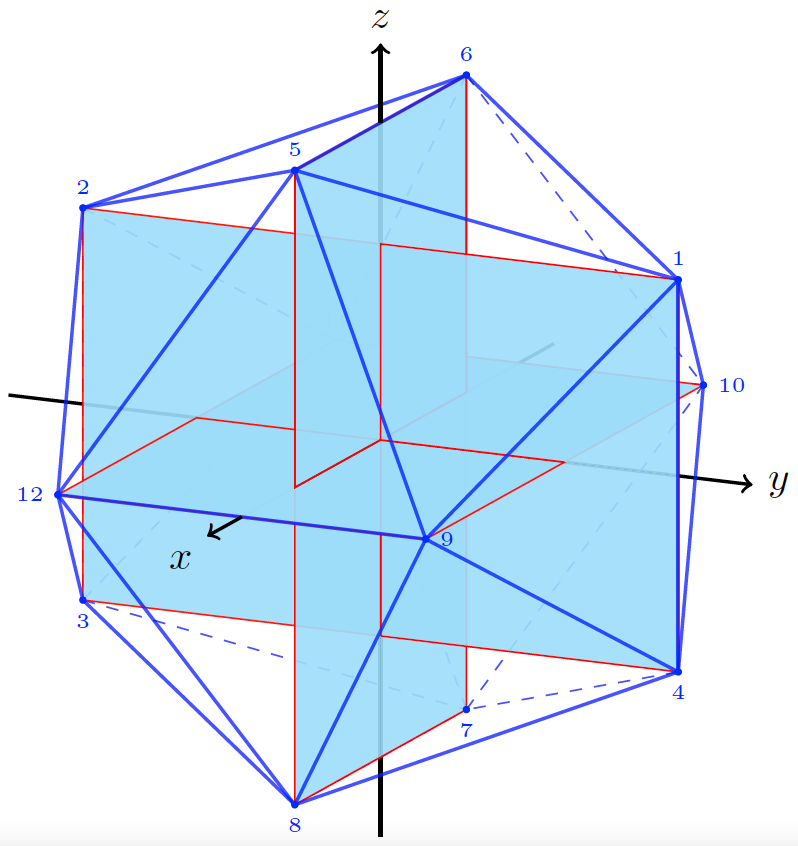Edit and compile if you like:
\documentclass{article}
\usepackage{tikz}
\usepackage{tikz-3dplot}
\usetikzlibrary{patterns}
\usepackage[active,tightpage]{preview}
\PreviewEnvironment{tikzpicture}
\setlength\PreviewBorder{1pt}
%
% File name: icosahedron-and-golden-rectangle.tex
% Description:
% A geometric representation of the construction of an icosahedron
% from three golden rectangles is shown.
%
% Date of creation: June, 20th, 2021.
% Date of last modification: October, 9th, 2022.
% Author: Efraín Soto Apolinar.
% https://www.aprendematematicas.org.mx/author/efrain-soto-apolinar/instructing-courses/
% Source: page 399 of the
% Glosario Ilustrado de Matem\'aticas Escolares.
% https://tinyurl.com/5udm2ufy
%
% Terms of use:
% According to TikZ.net
% https://creativecommons.org/licenses/by-nc-sa/4.0/
% Your commitment to the terms of use is greatly appreciated.
%
\begin{document}
%
\begin{center}
\tdplotsetmaincoords{75}{115}
%
\begin{tikzpicture}[tdplot_main_coords,scale=1.75]
\pgfmathsetmacro{\aureo}{0.5 * (1.0 + sqrt(5.0))} % the golden number
\pgfmathsetmacro{\unidad}{1.0}
\coordinate (1) at (0,\aureo,1);
\coordinate (2) at (0,-\aureo,1);
\coordinate (3) at (0,-\aureo,-1);
\coordinate (4) at (0,\aureo,-1);
\coordinate (5) at (1,0,\aureo);
\coordinate (6) at (-1,0,\aureo);
\coordinate (7) at (-1,0,-\aureo);
\coordinate (8) at (1,0,-\aureo);
\coordinate (9) at (\aureo,1,0);
\coordinate (10) at (-\aureo,1,0);
\coordinate (11) at (-\aureo,-1,0);
\coordinate (12) at (\aureo,-1,0);
% Coordinate axis
\draw[thick] (-1.25*\aureo,0,0) -- (\aureo,0,0); % Eje x
\draw[thick,->] (0,-1.25*\aureo,0,0) -- (0,1.25*\aureo,0) node[right] {$y$}; % Eje y
\draw[thick] (0,0,-1.25*\aureo) -- (0,0,\aureo); % Eje z
% Hidden edges
\draw[blue,dashed,opacity=0.75] (6) -- (10);
\draw[blue,dashed,opacity=0.75] (6) -- (11);
\draw[blue,dashed,opacity=0.75] (10) -- (11);
\draw[blue,dashed,opacity=0.75] (2) -- (11);
\draw[blue,dashed,opacity=0.75] (3) -- (11);
\draw[blue,dashed,opacity=0.75] (7) -- (11);
\draw[blue,dashed,opacity=0.75] (7) -- (10);
\draw[blue,dashed,opacity=0.75] (4) -- (7);
\draw[blue,dashed,opacity=0.75] (3) -- (7);
\draw[blue,dashed,opacity=0.75] (8) -- (7);
\draw[blue,dashed,opacity=0.75] (2) -- (3);
\fill[blue] (11) circle (0.5pt) node [above] {\tiny$11$};
% Golden rectangles
\fill[cyan!35,opacity=0.9] (0,0,0) -- (-1,0,0) -- (-1,0,-\aureo) -- (0,0,-\aureo) -- cycle; % y = 0, for z < 0
\draw[red] (0,0,0) -- (-1,0,0) -- (-1,0,-\aureo) -- (0,0,-\aureo); % y = 0, for z < 0
\fill[cyan!35,opacity=0.9] (0,0,0) -- (0,\aureo,0) -- (0,\aureo,-1) -- (0,0,-1) -- cycle; % x = 0, for y > 0
\draw[red] (0,0,0) -- (0,0,-1) -- (0,\aureo,-1) -- (0,\aureo,0) ; % x = 0, for y > 0
\draw[red,fill=cyan!35,opacity=0.9] (0,1,0) -- (-\aureo,1,0) -- (-\aureo,-1,0) -- (0,-1,0) -- cycle; % z = 0, for x < 0
\draw[red,fill=cyan!35,opacity=0.9] (0,0,1) -- (0,-\aureo,1) -- (0,-\aureo,-1) -- (0,0,-1) -- cycle; % x = 0, for y < 0
\fill[cyan!35,opacity=0.9] (1,0,0) -- (0,0,0) -- (0,0,-\aureo) -- (1,0,-\aureo) -- cycle; % y = 0, for z < 0
\draw[red] (0,0,-1) -- (0,0,0) -- (1,0,0) -- (1,0,-\aureo) -- (0,0,-\aureo); % y = 0, for z < 0
\draw[red,fill=cyan!35,opacity=0.9] (\aureo,1,0) -- (0,1,0) -- (0,-1,0) -- (\aureo,-1,0) -- cycle; % z = 0, for x > 0
\draw[fill=cyan!35,opacity=0.9] (1,0,\aureo) -- (-1,0,\aureo) -- (-1,0,0) -- (1,0,0) -- cycle; % y = 0, for z > 0
\draw[red] (1,0,\aureo) -- (-1,0,\aureo) -- (-1,0,0) -- (1,0,0) -- cycle; % y = 0, for z > 0
\fill[cyan!35,opacity=0.9] (0,0,1) -- (0,\aureo,1) -- (0,\aureo,0) -- (0,0,0) -- cycle; % x = 0, for y > 0
\draw[red] (0,1,0) -- (0,0,0) -- (0,0,1) -- (0,\aureo,1) -- (0,\aureo,0); % x = 0, for y > 0
% Visible edges
\draw[blue,thick,opacity=0.75] (5) -- (1);
\draw[blue,thick,opacity=0.75] (5) -- (2);
\draw[blue,thick,opacity=0.75] (5) -- (12);
\draw[blue,thick,opacity=0.75] (5) -- (9);
\draw[blue,thick,opacity=0.75] (5) -- (6);
\draw[blue,thick,opacity=0.75] (9) -- (4);
\draw[blue,thick,opacity=0.75] (9) -- (8);
\draw[blue,thick,opacity=0.75] (9) -- (1);
\draw[blue,thick,opacity=0.75] (6) -- (1);
\draw[blue,thick,opacity=0.75] (2) -- (12);
\draw[blue,thick,opacity=0.75] (9) -- (12);
\draw[blue,thick,opacity=0.75] (8) -- (12);
\draw[blue,thick,opacity=0.75] (4) -- (8);
\draw[blue,thick,opacity=0.75] (4) -- (1);
\draw[blue,thick,opacity=0.75] (2) -- (6);
\draw[blue,thick,opacity=0.75] (3) -- (12);
\draw[blue,thick,opacity=0.75] (8) -- (3);
\draw[blue,thick,opacity=0.75] (10) -- (1);
\draw[blue,thick,opacity=0.75] (4) -- (10);
% Coordinate axis (last part)
\draw[thick,->] (\aureo,0,0) -- (1.25*\aureo,0,0) node[below left] {$x$}; % $x$ axis
\draw[thick,->] (0,0,\aureo) -- (0,0,1.25*\aureo) node [above] {$z$}; % $z$ axis
% The vertices
\foreach \punto/\lugar in {1/above,2/above,3/below, 4/below,5/above, 6/above, 7/below, 8/below, 9/right, 10/right, 12/left}{
\fill[blue] (\punto) circle (0.5pt) node [\lugar] {\tiny$\punto$};
}
%
\end{tikzpicture}
\end{center}
%
\end{document}
Click to download: icosahedron-and-golden-rectangle.tex • icosahedron-and-golden-rectangle.pdf
Open in Overleaf: icosahedron-and-golden-rectangle.tex
See more on the author page of Efraín Soto Apolinar.


